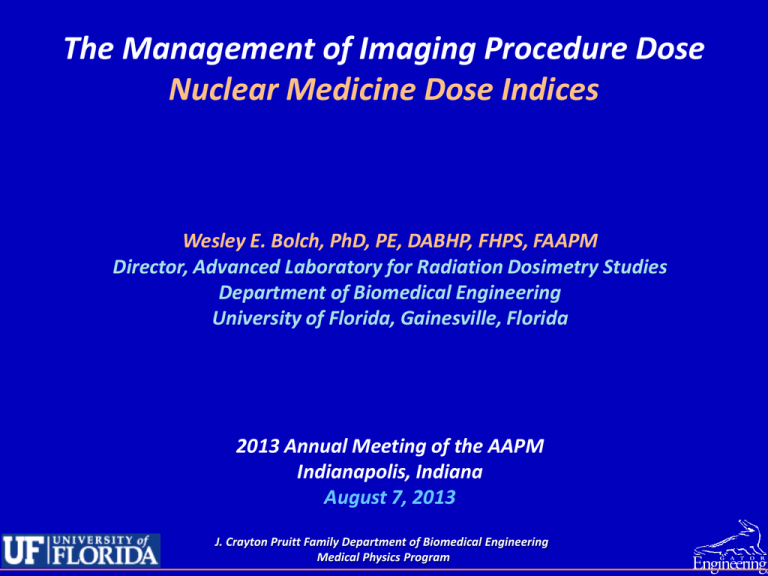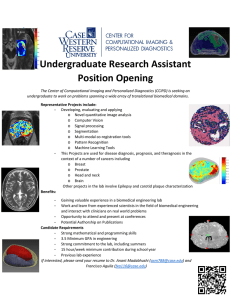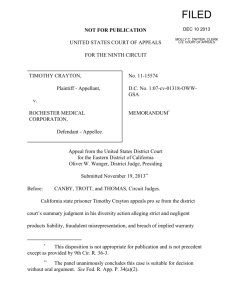The Management of Imaging Procedure Dose Nuclear Medicine Dose Indices
advertisement

The Management of Imaging Procedure Dose Nuclear Medicine Dose Indices Wesley E. Bolch, PhD, PE, DABHP, FHPS, FAAPM Director, Advanced Laboratory for Radiation Dosimetry Studies Department of Biomedical Engineering University of Florida, Gainesville, Florida 2013 Annual Meeting of the AAPM Indianapolis, Indiana August 7, 2013 J. Crayton Pruitt Family Department of Biomedical Engineering Medical Physics Program Dosimetry in Nuclear Medicine The main clinical application of diagnostic nuclear medicine is • functional imaging of normal and diseased tissues; and • localization of malignant tissue and its metastatic spread In these applications, the amount of administered activity is such that the absorbed dose to both imaged and non-imaged tissues is typically very low. Consequently, stochastic risks of cancer induction are greatly outweighed by the diagnostic benefit of the imaging procedure. J. Crayton Pruitt Family Department of Biomedical Engineering Medical Physics Program Dosimetry in Nuclear Medicine Tissue doses and their stochastic risks can be quantified and placed in context of both their cumulative values over multiple imaging sessions, as well as against associated risks from other diagnostic procedures (fluoroscopy, CT, etc.) The role of internal dosimetry in diagnostic nuclear medicine is thus to provide the basis for stochastic risk quantification. Once this risk is quantified, it may be used to optimize the amount of administered activity so as to… • Maximize image quality / diagnostic information • Minimize patient risk J. Crayton Pruitt Family Department of Biomedical Engineering Medical Physics Program Example – Benefit to Risk Ratio in NM? J. Crayton Pruitt Family Department of Biomedical Engineering Medical Physics Program Example – Benefit to Risk Ratio in NM? J. Crayton Pruitt Family Department of Biomedical Engineering Medical Physics Program Review by Pat Zanzonico (2010 SNM) Data • • • • Conventional pre-op work-up → Thoracotomy: Thoracotomy futile: Conventional pre-op work-up → Thoracotomy: w/ PET Thoracotomy futile: Surgery (Sx)-related mortality: w/ PET → Avoided futile Sx: 81% (78 / 97) 41% (39 / 78) 65% (60 / 92) 21% (19 / 60) 6.5% 20% Extrapolation Van Tinteren et al. Lancet 359: 1388, 2002 • • • • • • • New lung cancers in US (2006): Conventional pre-op work-up → Futile-Sx deaths: Conventional pre-op work-up → Futile-Sx deaths: + PET Gross benefit of pre-op PET - Lives saved w/ PET: 18FDG ED / 10 mCi: Excess cancer deaths: Net benefit of pre-op PET - Lives saved w/ PET: J. Crayton Pruitt Family Department of Biomedical Engineering Medical Physics Program 174,470 3,766 1,547 /yr /yr /yr 2,219 /yr 7 mSv 61 /yr 2,158 /yr B/R Ratio - 32 Quantities for Dose Tracking in Medical Imaging A dose index is a measureable quantity that is indicative of patient expose, and which when multiplied by an appropriate dose coefficient, can yield an estimate of patient organ dose or whole-body effective dose. Imaging Procedure Radiography Fluoroscopy Computed Tomography Nuclear Medicine 𝑫𝑫𝑫𝑫𝑫𝑫𝑫𝑫 𝑸𝑸𝑸𝑸𝑸𝑸𝑸𝑸𝑸𝑸𝑸𝑸𝑸𝑸𝑸𝑸 = Dose Index Entrance Skin Dose Dose Area Product Volumetric CTDI Injected Activity 𝑫𝑫𝑫𝑫𝑫𝑫𝑫𝑫 𝑰𝑰𝑰𝑰𝑰𝑰𝑰𝑰𝑰𝑰 × 𝑫𝑫𝑫𝑫𝑫𝑫𝑫𝑫 𝑪𝑪𝑪𝑪𝑪𝑪𝑪𝑪𝑪𝑪𝑪𝑪𝑪𝑪𝑪𝑪𝑪𝑪𝑪𝑪𝑪𝑪 J. Crayton Pruitt Family Department of Biomedical Engineering Medical Physics Program Dose Coefficients from ICRP ICRP Publication 53 (1988) ICRP Publication 80 (1998) ICRP Publication 106 (2008) J. Crayton Pruitt Family Department of Biomedical Engineering Medical Physics Program Dose Coefficients from ICRP J. Crayton Pruitt Family Department of Biomedical Engineering Medical Physics Program Dose Coefficients from ICRP J. Crayton Pruitt Family Department of Biomedical Engineering Medical Physics Program Dose Coefficients from ICRP J. Crayton Pruitt Family Department of Biomedical Engineering Medical Physics Program Dose Coefficients for 18F-FDG / ICRP 106 J. Crayton Pruitt Family Department of Biomedical Engineering Medical Physics Program Other Resources for Dose Coefficients Society of Nuclear Medicine and Molecular Imaging (SNMMI) • Medical Internal Dose Committee (MIRD) • Dose Estimate Reports – Published in the Journal of Nuclear Medicine (JNM) • RADAR Task Force • Website – www.doseinfor-radar.com • OLINDA / EXM software J. Crayton Pruitt Family Department of Biomedical Engineering Medical Physics Program What is the basis for these dose coefficients? First, we need to look at the MIRD Schema for nuclear medicine dose assessment: J. Crayton Pruitt Family Department of Biomedical Engineering Medical Physics Program MIRD Schema – Absorbed Dose Mean absorbed dose to tissue rT from activity in tissue rS Time-integrated activity – total number of nuclear decays in rS Radionuclide S value – absorbed dose to rT per nuclear decay in rS J. Crayton Pruitt Family Department of Biomedical Engineering Medical Physics Program MIRD Schema – Dose Coefficient d = D/A0 Time-dependent form: Time-independent form: J. Crayton Pruitt Family Department of Biomedical Engineering Medical Physics Program MIRD Schema To fully calculate organ doses, the following information is needed from the patient… Biokinetic parameters • Identification of source organs • The time dependent profile of activity in these organs A(rS , t ) Physics parameters • Energies and yields of all radiation particles emitted by the radionuclide Anatomic parameters • Masses of all target organs in the patient • Values of absorbed fraction φ (rT ← rS ) for all rS and rT pairs J. Crayton Pruitt Family Department of Biomedical Engineering Medical Physics Program 1. Biokinetic Parameters The ICRP dose coefficients are based upon standardized biokinetic models for “reference” patients. Typically, no adjustments are made for age-dependence of biokinetic parameters – only organ masses are changed with age. Example – Biokinetic model of iodine used by the ICRP in previous publications J. Crayton Pruitt Family Department of Biomedical Engineering Medical Physics Program 1. Biokinetic Parameters Example – Biokinetic model of iodine presently used by the ICRP J. Crayton Pruitt Family Department of Biomedical Engineering Medical Physics Program 1. Biokinetic Parameters Example – Biokinetic model of iodine presently used by the ICRP Note – these transfer rates are fixed and constant, and thus not adjustable to individual patients J. Crayton Pruitt Family Department of Biomedical Engineering Medical Physics Program 1. Biokinetic Parameters For individual patients, however, nuclear medicine imaging is performed via… • 2D planar imaging, or • 3D SPECT imaging, or • 3D PET imaging and thus direct data on the patient’s own metabolism and biodistribution of the radiopharmaceutical are explicitly measured. No reliance is made on a standardized biokinetic model. J. Crayton Pruitt Family Department of Biomedical Engineering Medical Physics Program 1. Biokinetic Parameters The problem is the number of images! For general diagnostic examinations, only a single image is taken at a time of optimal radiopharmaceutical uptake. For dosimetric evaluations, however, multiple images are needed to obtain the time-activity curve A(rS , t ). This is typically only viable during drug development or within a research clinical trial protocol. Conclusion - This is a prime reason why one cannot go beyond injected activity as a dose index for patient dose tracking. J. Crayton Pruitt Family Department of Biomedical Engineering Medical Physics Program 1. Biokinetic Parameters Imaging Uncertainties J. Crayton Pruitt Family Department of Biomedical Engineering Medical Physics Program 1. Biokinetic Parameters Imaging Uncertainties Results from Physical Phantom Measurements J. Crayton Pruitt Family Department of Biomedical Engineering Medical Physics Program 1. Biokinetic Parameters Imaging Uncertainties Results from Monte Carlo Simulations J. Crayton Pruitt Family Department of Biomedical Engineering Medical Physics Program 1. Biokinetic Parameters Individual Patient Variations Most biokinetic models do not take into account disease states, functional organ impairment, the influence of other medications, or other influences that can substantially alter biokinetics. The literature includes a few examples where this is considered . (e.g., the 1975 report by Cloutier et al. on the dosimetry of 198Au colloid in various states of liver disease). J. Crayton Pruitt Family Department of Biomedical Engineering Medical Physics Program 1. Biokinetic Parameters Individual Patient Variations Urinary Excretion 166Ho-DOTMP radiation-absorbed dose estimation for skeletal targeted radiotherapy. J Nucl Med. 2006;47:534–542. J. Crayton Pruitt Family Department of Biomedical Engineering Medical Physics Program 1. Biokinetic Parameters Individual Patient Variations Red marrow fractional uptake COV ~19% Red marrow residence time COV ~39% J. Crayton Pruitt Family Department of Biomedical Engineering Medical Physics Program 2. Physics Parameters MIRD Decay Scheme Monograph (2008) ICRP Publication 107 (2008) J. Crayton Pruitt Family Department of Biomedical Engineering Medical Physics Program 3. Anatomic Parameters The ICRP dose coefficients are based upon standardized anatomical models of “reference” persons – those at 50% height and weight, and with “average” organ masses. ICRP Publication 89 (2002) J. Crayton Pruitt Family Department of Biomedical Engineering Medical Physics Program 3. Anatomic Parameters Liver mass → COV of 21 to 25% J. Crayton Pruitt Family Department of Biomedical Engineering Medical Physics Program Computational Anatomic Phantoms Phantom Types and Categories • Phantom Format Types Stylized (or mathematical) phantoms Voxel (or tomographic) phantoms Hybrid (or NURBS/PM) phantoms • Phantom Morphometric Categories Reference (50th percentile individual, patient matching by age only) Patient-dependent (patient matched by nearest height / weight) Patient-sculpted (patient matched to height, weight, and body contour) Patient-specific (phantom uniquely matching patient morphometry) J. Crayton Pruitt Family Department of Biomedical Engineering Medical Physics Program UF Series of Reference Hybrid Phantoms Newborn 1-year 5-year 10-year 15-year male 15-year female Adult male Key Feature: MicroCT image-based models of active marrow and endosteum dosimetry for both internal electron sources and whole-body photon sources J. Crayton Pruitt Family Department of Biomedical Engineering Medical Physics Program Adult female 3. Anatomic Parameters – Reference Phantoms Photon Φ(muscle ← lungs) for all phantoms in the UF phantom family J. Crayton Pruitt Family Department of Biomedical Engineering Medical Physics Program 3. Anatomic Parameters – Reference Phantoms A subset of the electron SAF curves for the thyroid source tissue in the newborn phantom J. Crayton Pruitt Family Department of Biomedical Engineering Medical Physics Program Continuum of Anatomic Specificity Pre-computed dose library Patient-specific dose calculation J. Crayton Pruitt Family Department of Biomedical Engineering Medical Physics Program Patient-Dependent Phantoms – Adults J. Crayton Pruitt Family Department of Biomedical Engineering Medical Physics Program Patient-Dependent Phantoms – Children J. Crayton Pruitt Family Department of Biomedical Engineering Medical Physics Program 3. Anatomic Parameters – Patient Variations I-131 J. Crayton Pruitt Family Department of Biomedical Engineering Medical Physics Program 3. Anatomic Parameters – Patient Variations I-131 J. Crayton Pruitt Family Department of Biomedical Engineering Medical Physics Program 3. Anatomic Parameters – Patient Variations I-131 J. Crayton Pruitt Family Department of Biomedical Engineering Medical Physics Program 3. Anatomic Parameters – State-of-the-Art On-the-fly Monte Carlo simulation using Patient’s CT and SPECT/PET images J. Crayton Pruitt Family Department of Biomedical Engineering Medical Physics Program Conclusions The only viable dose index for patient “dose tracking” in nuclear medicine would be injected activity. However, to infer organ and effective dose, one would have to rely on reference models for both… • Radiopharmaceutical biokinetics • Organ masses and values of absorbed fraction Future improvements may be made in expanding dose coefficients to include • An expanded library of computational phantoms of varying age, height, and weight with associated radionuclide S values – work in progress • Parameterized biokinetic models for different patient disease states and genetic makeup – logistically difficult and likely to be prohibitively costly J. Crayton Pruitt Family Department of Biomedical Engineering Medical Physics Program Thank you for your attention… Disclosures: Work supported in part by NIH Grants R01 CA96441 R01 CA116743 R01 EB013558 Contract with NCI/REB J. Crayton Pruitt Family Department of Biomedical Engineering Medical Physics Program






